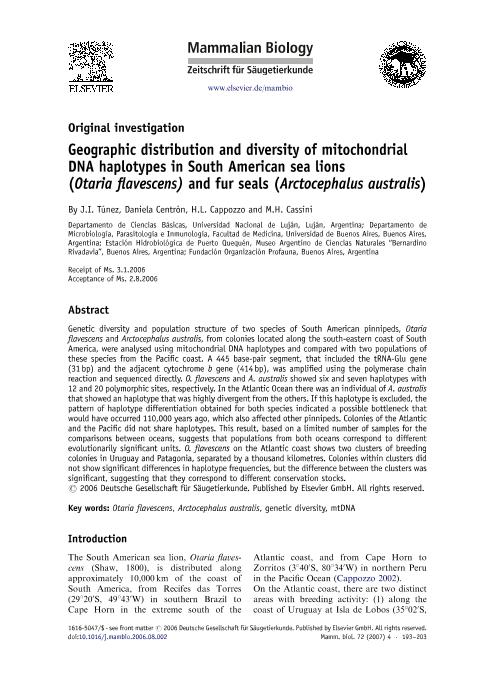Mostrar el registro sencillo del ítem
dc.contributor.author
Tunez, Juan Ignacio

dc.contributor.author
Centron, Daniela

dc.contributor.author
Cappozzo, Humberto Luis

dc.contributor.author
Cassini, Marcelo Hernan

dc.date.available
2021-07-08T18:16:59Z
dc.date.issued
2007-07-20
dc.identifier.citation
Tunez, Juan Ignacio; Centron, Daniela; Cappozzo, Humberto Luis; Cassini, Marcelo Hernan; Geographic distribution and diversity of mitochondrial DNA haplotypes in South American sea lions (Otaria flavescens) and fur seals (Arctocephalus australis); Elsevier Gmbh; Mammalian Biology; 72; 4; 20-7-2007; 193-203
dc.identifier.issn
1616-5047
dc.identifier.uri
http://hdl.handle.net/11336/135742
dc.description.abstract
Genetic diversity and population structure of two species of South American pinnipeds, Otaria flavescens and Arctocephalus australis, from colonies located along the south-eastern coast of South America, were analysed using mitochondrial DNA haplotypes and compared with two populations of these species from the Pacific coast. A 445 base-pair segment, that included the tRNA-Glu gene (31 bp) and the adjacent cytochrome b gene (414 bp), was amplified using the polymerase chain reaction and sequenced directly. O. flavescens and A. australis showed six and seven haplotypes with 12 and 20 polymorphic sites, respectively. In the Atlantic Ocean there was an individual of A. australis that showed an haplotype that was highly divergent from the others. If this haplotype is excluded, the pattern of haplotype differentiation obtained for both species indicated a possible bottleneck that would have occurred 110,000 years ago, which also affected other pinnipeds. Colonies of the Atlantic and the Pacific did not share haplotypes. This result, based on a limited number of samples for the comparisons between oceans, suggests that populations from both oceans correspond to different evolutionarily significant units. O. flavescens on the Atlantic coast shows two clusters of breeding colonies in Uruguay and Patagonia, separated by a thousand kilometres. Colonies within clusters did not show significant differences in haplotype frequencies, but the difference between the clusters was significant, suggesting that they correspond to different conservation stocks.
dc.format
application/pdf
dc.language.iso
eng
dc.publisher
Elsevier Gmbh

dc.rights
info:eu-repo/semantics/openAccess
dc.rights.uri
https://creativecommons.org/licenses/by-nc-sa/2.5/ar/
dc.subject
ARCTOCEPHALUS AUSTRALIS
dc.subject
GENETIC DIVERSITY
dc.subject
MTDNA
dc.subject
OTARIA FLAVESCENS
dc.subject.classification
Ecología

dc.subject.classification
Ciencias Biológicas

dc.subject.classification
CIENCIAS NATURALES Y EXACTAS

dc.title
Geographic distribution and diversity of mitochondrial DNA haplotypes in South American sea lions (Otaria flavescens) and fur seals (Arctocephalus australis)
dc.type
info:eu-repo/semantics/article
dc.type
info:ar-repo/semantics/artículo
dc.type
info:eu-repo/semantics/publishedVersion
dc.date.updated
2021-06-29T14:59:44Z
dc.journal.volume
72
dc.journal.number
4
dc.journal.pagination
193-203
dc.journal.pais
Alemania

dc.description.fil
Fil: Tunez, Juan Ignacio. Universidad Nacional de Luján. Departamento de Ciencias Básicas. Grupo de Estudios en Ecología de Mamíferos; Argentina. Consejo Nacional de Investigaciones Científicas y Técnicas. Oficina de Coordinación Administrativa Parque Centenario. Universidad Nacional de Luján. Instituto de Ecología y Desarrollo Sustentable; Argentina. Consejo Nacional de Investigaciones Científicas y Técnicas. Oficina de Coordinación Administrativa Parque Centenario. Museo Argentino de Ciencias Naturales "Bernardino Rivadavia"; Argentina. Consejo Nacional de Investigaciones Científicas y Técnicas; Argentina
dc.description.fil
Fil: Centron, Daniela. Consejo Nacional de Investigaciones Científicas y Técnicas. Oficina de Coordinación Administrativa Houssay. Instituto de Investigaciones en Microbiología y Parasitología Médica. Universidad de Buenos Aires. Facultad de Medicina. Instituto de Investigaciones en Microbiología y Parasitología Médica; Argentina
dc.description.fil
Fil: Cappozzo, Humberto Luis. Consejo Nacional de Investigaciones Científicas y Técnicas. Oficina de Coordinación Administrativa Parque Centenario. Museo Argentino de Ciencias Naturales "Bernardino Rivadavia"; Argentina
dc.description.fil
Fil: Cassini, Marcelo Hernan. Consejo Nacional de Investigaciones Científicas y Técnicas. Oficina de Coordinación Administrativa Parque Centenario. Museo Argentino de Ciencias Naturales "Bernardino Rivadavia"; Argentina. Consejo Nacional de Investigaciones Científicas y Técnicas. Instituto de Biología y Medicina Experimental. Fundación de Instituto de Biología y Medicina Experimental. Instituto de Biología y Medicina Experimental; Argentina
dc.journal.title
Mammalian Biology

dc.relation.alternativeid
info:eu-repo/semantics/altIdentifier/url/https://www.sciencedirect.com/science/article/abs/pii/S1616504706001108
dc.relation.alternativeid
info:eu-repo/semantics/altIdentifier/doi/https://doi.org/10.1016/j.mambio.2006.08.002
Archivos asociados
